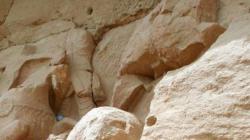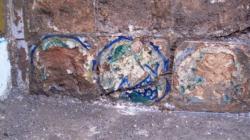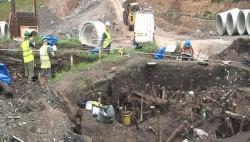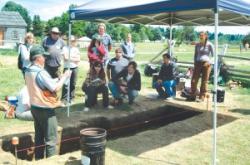INSTITUT SUPERIEUR D'ANTHROPOLOGIE
INSTITUTE OF ANTHROPOLOGY
ONLINE COURSES / COURS A DISTANCE
INSCRIPTION 2012 / Session III : Juillet 2012
REGISTRATION 2012 / Term III : July 2012
IRAN –  Jeyran hill - Archaeologists have excavated ancient ritual platforms dating back to Iron Age in Jeyran hill located in the Iranian province of North Khorasan. Concerning their specifications, the platforms discovered in Iran are unique, said deputy head of Cultural Heritage and Tourism Organization (CHTO) for cultural heritage affairs in North Khorasan as well as team leader Ali Akbar Vahdati. He also noted that similar platforms have been unearthed in several Middle Asian countries such as Turkmenistan so far. The studies demonstrate that the platforms do not yield the area as a residential sector, Vahdati explained. The experts suggest that people, inhabited the region about 1500 years ago, used the place for ritual ceremonies and paid tribute to these platforms. While a number of graves have also been found in the area, archaeologists believe the ancient inhabitants of the region used to put their dead in open space, then buried them after performing rituals.
Jeyran hill - Archaeologists have excavated ancient ritual platforms dating back to Iron Age in Jeyran hill located in the Iranian province of North Khorasan. Concerning their specifications, the platforms discovered in Iran are unique, said deputy head of Cultural Heritage and Tourism Organization (CHTO) for cultural heritage affairs in North Khorasan as well as team leader Ali Akbar Vahdati. He also noted that similar platforms have been unearthed in several Middle Asian countries such as Turkmenistan so far. The studies demonstrate that the platforms do not yield the area as a residential sector, Vahdati explained. The experts suggest that people, inhabited the region about 1500 years ago, used the place for ritual ceremonies and paid tribute to these platforms. While a number of graves have also been found in the area, archaeologists believe the ancient inhabitants of the region used to put their dead in open space, then buried them after performing rituals.
http://www.presstv.ir/detail/252236.html
IRAN –  Gaskar - Iranian archeologists have unearthed remains of an ancient workshop during excavations in the historical city of Gaskar in the northern province of Gilan. The second phase of archeological excavations yielded the 1200-year-old structure along with a collection of tiles from the Islamic era. Archeologists say the workshop had probably been part of a two-storey building with brick walls and two large rooms. Remains of a kiln and divisions of the structure’s internal space suggest it had been a public place used as a workshop of some kind. The Islamic tiles discovered during the excavation project bear human figures and are among the most important archeological finds from the Islamic era in the region. “Recent excavations also yielded new sections of the structures discovered during previous projects including parts of a brick wall believed to have been the entrance to a public bath,” head of the archeology team Vali Jahani told CHN. “The interesting thing about the building is that its floor was made with bricks and then covered with tiles,” he added. Gaskar is located 55 kilometers to the provincial capital of Rasht and is now covered with the heavy forest of Haft Daghanan. Archeological excavations have yielded many sites and artifacts in northern Iran over the past decade. One of the most famous archeological sites in Iran’s Gilan Province is Marlik near the city of Roudbar. The site of a royal cemetery, and artifacts found at this site date back to 3,000 years ago.
Gaskar - Iranian archeologists have unearthed remains of an ancient workshop during excavations in the historical city of Gaskar in the northern province of Gilan. The second phase of archeological excavations yielded the 1200-year-old structure along with a collection of tiles from the Islamic era. Archeologists say the workshop had probably been part of a two-storey building with brick walls and two large rooms. Remains of a kiln and divisions of the structure’s internal space suggest it had been a public place used as a workshop of some kind. The Islamic tiles discovered during the excavation project bear human figures and are among the most important archeological finds from the Islamic era in the region. “Recent excavations also yielded new sections of the structures discovered during previous projects including parts of a brick wall believed to have been the entrance to a public bath,” head of the archeology team Vali Jahani told CHN. “The interesting thing about the building is that its floor was made with bricks and then covered with tiles,” he added. Gaskar is located 55 kilometers to the provincial capital of Rasht and is now covered with the heavy forest of Haft Daghanan. Archeological excavations have yielded many sites and artifacts in northern Iran over the past decade. One of the most famous archeological sites in Iran’s Gilan Province is Marlik near the city of Roudbar. The site of a royal cemetery, and artifacts found at this site date back to 3,000 years ago.
http://presstv.com/detail/2012/07/30/253523/northern-iran-yields-ancient-workshop/
ROYAUME UNI -  Enniskillen - The environment minister has imposed a "no-go zone" around an archaeological site on the route of a new road in County Fermanagh. Ancient human remains and pottery were unearthed at the site in Enniskillen. Archaeologists are currently excavating the crannog - a kind of artificial island - and have said that it could date back more than 1,000 years. The minister, Alex Attwood, has banned construction traffic from passing close to the crannog during excavation work. A period of seven weeks was allocated for archaeologists to examine and record the crannog before the construction went ahead. The IfA said this was inadequate. The crannog was originally thought to be 700 years old, but fragments of pottery found at the site date from as far back as the ninth century. Other finds include arrowheads dating from the Bronze Age, a leather shoe which was preserved in the earth and a fine-toothed comb made from bone.
Enniskillen - The environment minister has imposed a "no-go zone" around an archaeological site on the route of a new road in County Fermanagh. Ancient human remains and pottery were unearthed at the site in Enniskillen. Archaeologists are currently excavating the crannog - a kind of artificial island - and have said that it could date back more than 1,000 years. The minister, Alex Attwood, has banned construction traffic from passing close to the crannog during excavation work. A period of seven weeks was allocated for archaeologists to examine and record the crannog before the construction went ahead. The IfA said this was inadequate. The crannog was originally thought to be 700 years old, but fragments of pottery found at the site date from as far back as the ninth century. Other finds include arrowheads dating from the Bronze Age, a leather shoe which was preserved in the earth and a fine-toothed comb made from bone.
http://www.bbc.co.uk/news/uk-northern-ireland-19053339
USA - Lake Champlain - Excavations have resumed at the site along Lake Champlain's western shore where American troops built an encampment during the War of 1812. They began digging last summer near the lakeshore at what was believed to be the site of an American encampment in the winter of 1812-13. The work has uncovered military artifacts that confirmed the site as Pike's Cantonment. About 2,000 soldiers wintered at the site and some 200 died while there. It was burned by British troops in 1813 after the Americans pulled out.
http://www.therepublic.com/view/story/89af428d01d54dccacc36de223b6aa54/NY--War-of-1812-Dig
USA - Fort Astoria/Fort George - National Park Service archaeologists will report on the first archaeological investigations of Fort Astoria/Fort George. Fort Astoria, established in 1811, was the first permanent American settlement west of the Rocky Mountains and the hub of a regional fur trade. During the War of 1812, it was the focal point of international tensions and by 1813, the fort was transferred to the British-owned North West Company. In 1818, the British ceremoniously returned the fort to the United States, but it continued to operate as “Fort George” under the Northwest Company and later the Hudson’s Bay Company.
http://www.dailyastorian.com/free/archaeologists-to-report-on-fort-george-dig/article_86fe3fd6-da6f-11e1-a167-0019bb2963f4.html
FRANCE –  Poitiers - Il y a tout juste un an, un diagnostic réalisé par l'INRAP sur le site des futurs jardins du Puygarreau affirmait la nécessité d'une fouille préventive. Le chantier doit démarrer le 6 août prochain pour une période de deux mois, en arrière de l'hôtel de ville.
Poitiers - Il y a tout juste un an, un diagnostic réalisé par l'INRAP sur le site des futurs jardins du Puygarreau affirmait la nécessité d'une fouille préventive. Le chantier doit démarrer le 6 août prochain pour une période de deux mois, en arrière de l'hôtel de ville.
Cette zone est très riche en vestiges. Elle a déjà permis la mise au jour de plusieurs éléments intéressants de la ville antique et médiévale : une fontaine, un forum, les murs de soubassement d'une chapelle…Dans quelques jours, une équipe d'une petite dizaine de personnes va travailler en permanence sur ce site de 750 m2, sous la responsabilité de Frédéric Gerber, ingénieur de recherches à l'INRAP. On espère en tout cas beaucoup en matière d'enrichissement des connaissances sur le Poitiers, pardon, le Lemonum du 1er siècle. S'il n'y a plus beaucoup de traces des occupations médiévales, on sait que les vestiges de la période antique sont sans doute bien mieux conservés. « On va probablement trouver de l'habitat bien conservé, probablement des domus, des maisons assez riches avec péristyles, jardins intérieurs, éventuellement des portes, des montants de fenêtres, de la décoration » précise Frédéric Gerber. Plusieurs états successifs ont d'ores et déjà été identifiés sur une hauteur de plus de 2 mètres. Enfin, à près de 6 mètres du niveau actuel de la rue, ce sont les sols les plus anciens de Poitiers qui devraient ainsi être fouillés.
http://www.lanouvellerepublique.fr/Toute-zone/Actualite/24-Heures/n/Contenus/Articles/2012/07/31/Puygarreau-va-s-offrir-deux-mois-de-fouilles